100 Years of Federal Forestry
Agriculture Information Bulletin No. 402
|

|

|
|
(Youth Conservation Corps, 0774 R 1142—11A)
|
The Look Ahead, 1976-
At the start of a new century of American forestry,
the Resources Planning Act of 1974 (see "Keeping Up With The Times,
1961-1975" on page 143.) will help set the pace for Forest Service
planning; for management protection, and development of the National
Forest System; for the Agency's research activities; and for programs of
cooperation with the States, private forest landowners, and countries
abroad. Under the Act, future national assessments and programs will
become more and more intensive. The assessment of future supply and
demand for renewable resources from the forests and associated
rangelands in public and private ownership in this country will be
updated in 1979 and every 10 years thereafter. The action programs will
be updated in 1980 and every 5 years after that.
There will be increasing concern for maintenance of
adequate raw material supplies needed by industry, but improved
techniques, accelerated forest management and protection activities,
stepped up treeplanting programs, and greater production from small
woodlands will help to meet the demands.
Research will play a key role in achieving better
utilization from available resources. For example, Forest Service
researchers, in cooperation with other government agencies and private
industry, are developing more efficient wood products for the
construction industry. A new technique will enable far greater use of
the wood in a tree than ever before. The process includes binding
together with glue the usually wasted chips, bark, shavings, and
sawdust, and combining them with solid wood to form a practical, durable
building material.
What does the future hold for other resources and
Forest Service activities?
There will be renewed emphasis, stemming from the
Endangered Species Act of 1973, on wildlife habitat requirements on the
National Forest System and on all forested lands.
Range grazing will contribute toward saving feed
grains for other uses, and will produce high quality food protein from
cattle thus raised. A minimum use of fossil fuel energy is required
since livestock converts forage directly to food.
Recreation trends point to greater and greater use of
the forest for all forms of outdoor recreation, particularly by families
for weekend use.
In protecting the forests against fire, researchers
are emphasizing fuel management. Work is already planned that should
produce sizable reductions in resource losses and firefighting
costs.
The never-ending battle against forest insects and
diseases, which each year destroy more trees than wildfires do, will
continue at an accelerated pace. Major research efforts will aim at
finding new weapons and new methods to control such insect pests as the
tussock moth, the gypsy moth, and the southern pine beetle, and such
forest diseases as the rusts, root rots, and the mistletoes.
Computers will become more important in Forest
Service work. By 1976, they were used for many purposes—for the
usual administrative functions, for simplifying studies involving masses
of statistics and information, for locating and laying out forest roads
thus saving field work time and expenses, for determining exact manpower
and equipment requirements for the control of active forest fires, and
for simplifying the work of forest manager and researcher alike. Another
new program is the planned Renewable Resources Technical Information
System (RRTIS) which started to take shape within the Forest Service in
1972. RRTIS will enable the foresters and other scientists and
engineers to keep track of, through computers, the technology that is
basic to decisions and actions. Data bases will be accessible from
remote terminals installed at various locations throughout the country.
Storage and prompt retrieval of documents will be essential parts of the
system.
1976-
"Perhaps the greatest challenge
facing forestry today is the calendar—namely the arrival of the
21st century. My question is, will American forestry be ready to meet
the 21st century?
"A major determinant of how
well American Forestry prepares for the 21st century will be cooperation
in resources management. This means cooperation among Federal, State,
and private ownerships; cooperation across long standing professional
barriers; and cooperation with new and different arrangements of people
and organizations, a trend which is becoming more evident with each
passing year. The interested general public is surprisingly
knowledgeable about natural resources. Yet people still need to hear
forestry's message—that sound forestry practices can provide both
protection and use."
John R. McGuire (1972- )
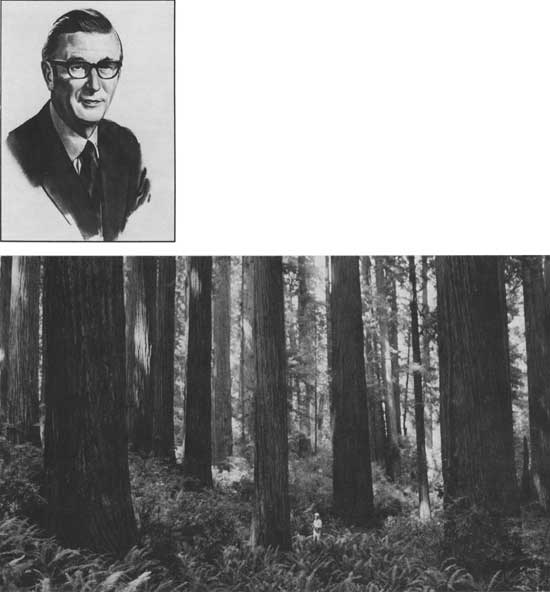
|
|
1 (top left). John R. McGuire, Chief of the Forest Service, 1972- .
(Drawing by Rudolph Wendelin) 2 (bottom). Old-growth redwood with typical undergrowth
of dense ferns in California. (F—493555)
|
100 Years of Federal Forestry (The Look Ahead, 1976-)
100 Years of Federal Forestry
Agriculture Information Bulletin No. 402
|

|
The Look Ahead, 1976-
(continued)
1976-
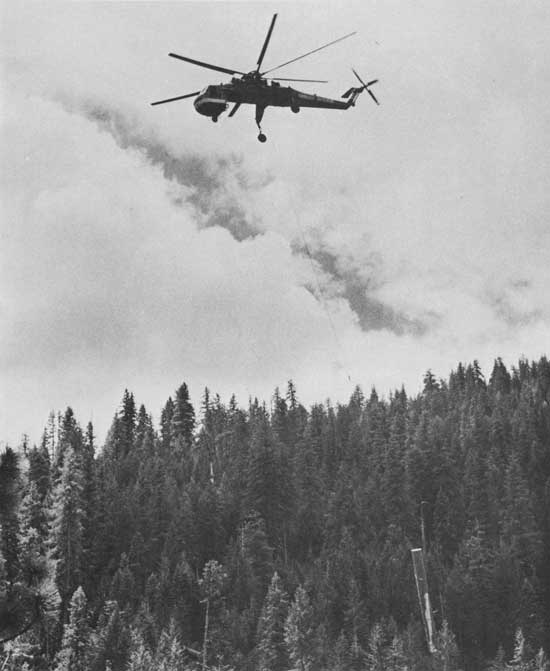
|
|
In today's research lies much of the anticipated progress of American
forestry in the tomorrow ahead. Out of the Forest Service's planning and development
efforts have already emerged these few exciting, photographed glimpses of new
technologies, new fields of exploration, and new improvements for the public benefit
in the days to come. 1. Harvesting by helicopter in inaccessible areas or steep
terrain, for more efficient, more economical logging through reductions in road
construction, in erosion, and in other damage to the land and remaining trees.
(F—521782)
|
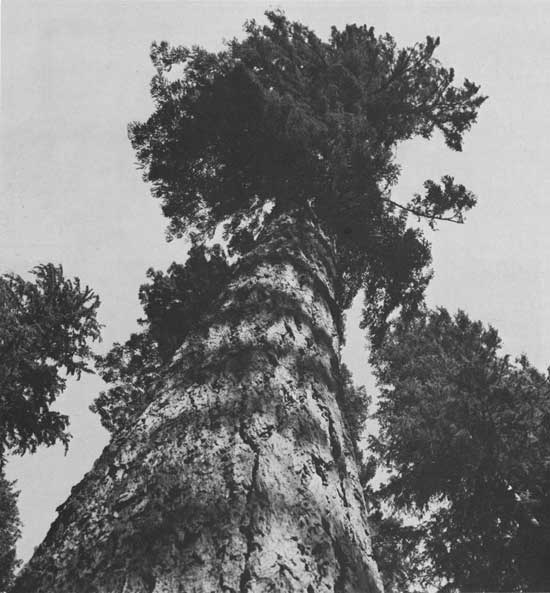
|
|
1. Douglas-fir in Oregon. (F—489660)
|
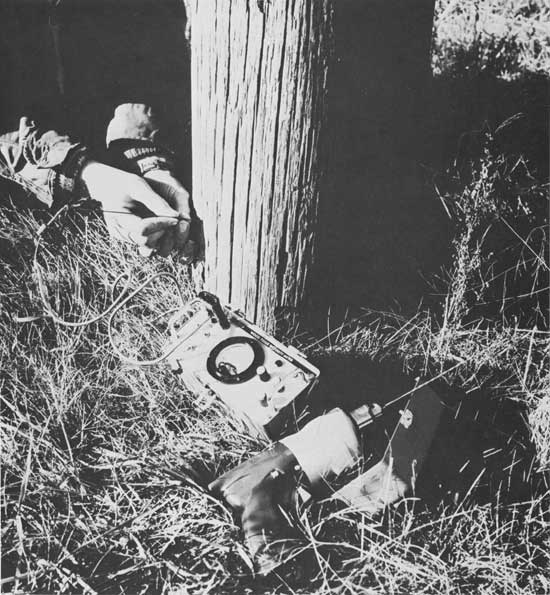
|
|
1. The Shigometer—a unique and practical instrument the
significance of which could be enormous for those who grow and use timber.
The Shigometer detects decay in its early stages in living trees and in
utility poles, decay not readily evident except after it has caused external
damage. This device can save time, expense, and the frequent failure involved
in extensive late treatment, or damage that results from no treatment at all.
The instrument is named for one of its principal originators, Alex Shigo,
plant pathologist with the Northwestern Forest Experiment Station, Durham,
New Hampshire. (Forest Service Northeastern Forest Experiment Station)
|
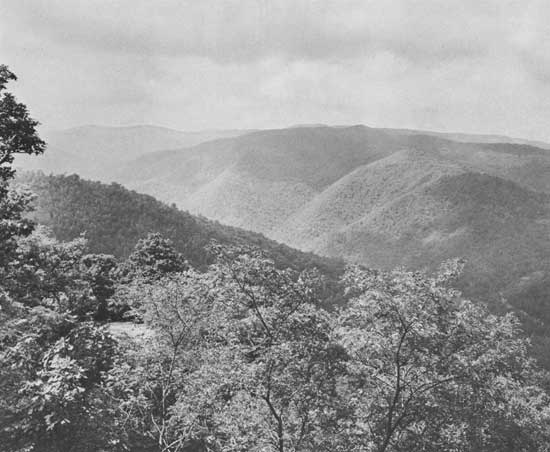
|
|
1. Pisgah National Forest, North Carolina. (F—504016)
|
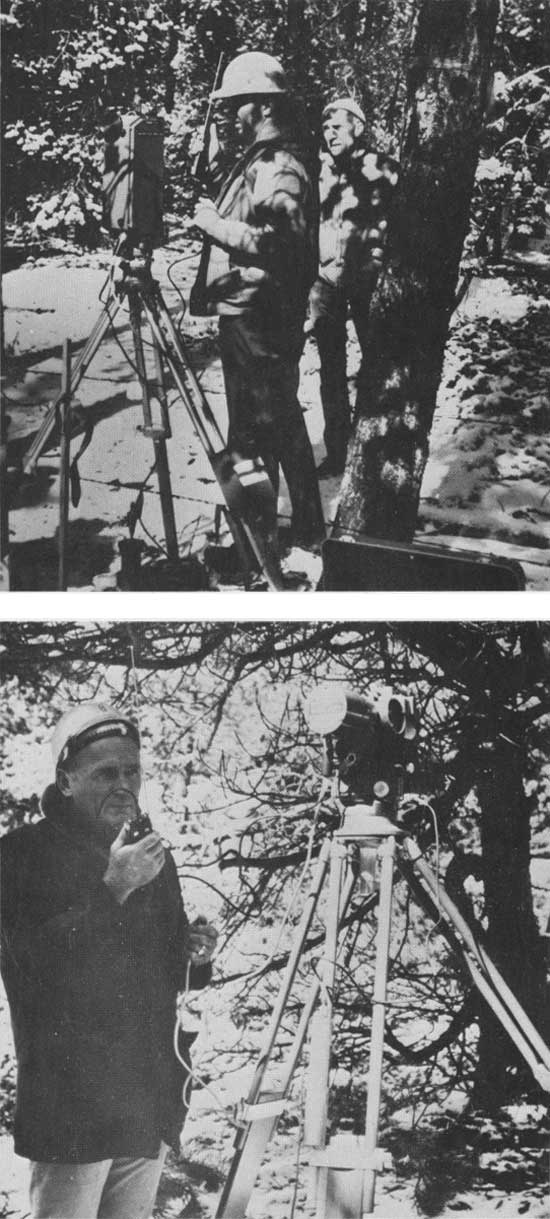
|
|
A new world of surveying opens up for the Forest Service with
use of the laser beam—the results of a 5-year joint venture between
Forest Service engineers and scientists of the National Aeronautics and Space
Administration. 1 (top). & 2 (bottom). The Laser Range Pole Transmitter
system and the Lower Range Pole Receiver theodolite subsystem work this way:
The transmitter beams a laser signal vertically in the air at one point
(property corner) and the receiver at an adjacent property corner picks up the
laser signal and projects a true, direct line between the two corners. The
equipment promises to reduce boundary survey time significantly. (F—523665, F—523666)
|
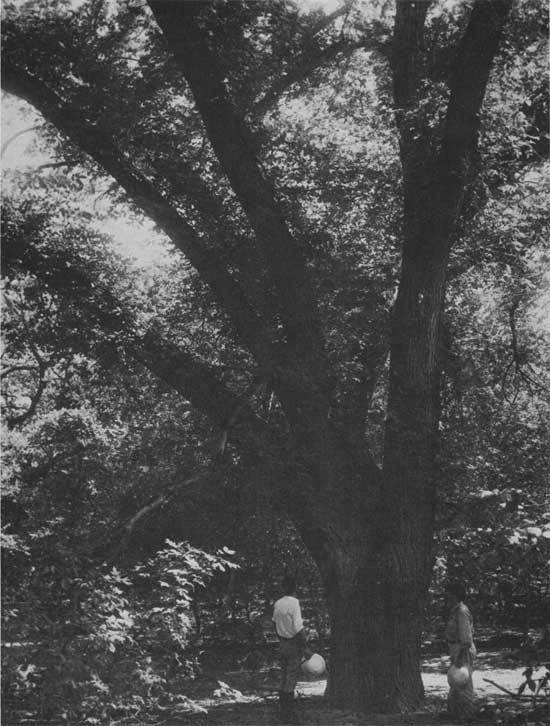
|
|
1. American elm in Kansas. This tree species is now severely
threatened with extinction by the Dutch elm disease. (F—368430)
|

|
|
1 (top right). & 2 (bottom). A leader in the race to meet America's
needs in the future is the Forest Products Laboratory, where the search goes on to find
new ways to use available timber more efficiently, to find uses for the less desirable
trees, to improve milling and other processing practices, and to develop new products.
(Forest Products Laboratory, M 143 403, Forest Products Laboratory, M 143 402)
|

|
|
1 (top). Bark of Engelemann spruce (Colorado). (F—438101)
|
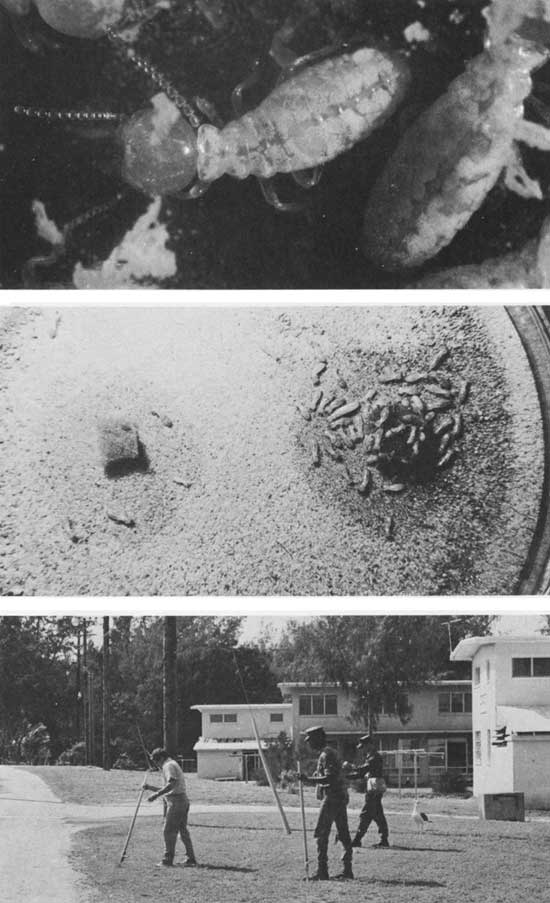
|
|
Have termites, which cost American home owners hundreds of millions of
dollars every year, finally met their match? Possibly so, in the form of
specially implanted "irresistible wood" that has proven fatal to
termites. The wood block bait is infected with a brown-rot fungus
attractive to termites, sterilized to kill the active fungus, then
impregnated with a small amount of slow-acting poison which must be
eaten by the termites to cause death. The termites are lured to the bait
from as far away as 3 feet. Still in its research stages in 1975
(approved by the Environmental Protection Agency for research only),
this wafer-bait system holds great promise for alleviating the
soil-dwelling termite problems the world over. A U.S. Navy facility on
Sand Island in the Midway Islands was one of the 1975 "proving grounds"
for the FPL study in termite control. 1 (top). A detailed look at termites. (Forest Products Laboratory) 2 (middle).
& 3 (bottom). Apparently environmentally safe and inexpensive, the wood block
system is easy to use. The research program on the Midway atoll involved
treating approximately 350 acres to protect 250 structures of various
sizes and types, including housing. Fourteen men helped entomologists
Glen Esenther (FPL) and Raymond Bell (Southern Forest Experiment
Station, Gulfport, Mississippi), co-developers of the bait system, treat
the entire area in the equivalent of one 40-hour week. (Forest Products
Laboratory, M 118 548; Forest Products Laboratory, M 143 306—15A)
|
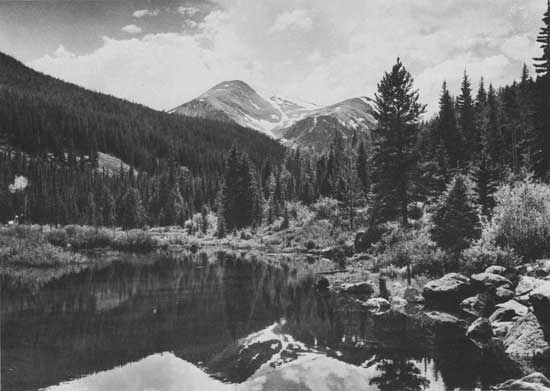
|
|
1. San Isabel National Forest, Colorado. (F—484364)
|

|
|
1 (top left), 2 (top right), & 3 (bottom). For many uses, there will
never be a substitute for wood. And no sophisticated instrument, no modern technology
is likely to replace the "ground troops," those who work with shovel, axe, and hose in the
final stages of bringing a forest fire under control. Forestry will always require the human
touch, foresters to provide person-to-person contacts, and personal handling of the
thousands of tasks associated with accomplishing the business of forestry. There is,
however, a powerful electronic force that cannot be denied, a force that many foresters have
eagerly sought and happily used since the beginning—the computer. The Forest Service
already is deeply committed to the use of computers. This use and dependence will increase
with the scheduled national assessments and expanding action programs of the future.
(F—505907, F—505902, F—517497)
|
aib-402/sec6.htm
Last Updated: 12-May-2008
|
|













